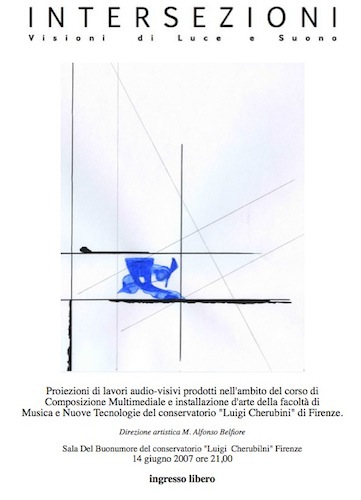DANTEUM
Alessio Nanni - Rodolfo Migliari
Also featured in the festival 'INTERSEZIONI - Visioni di luce e suono'
State Conservatory of Florence, Italy 2007

Danteum is an acoustic-visual installation deeply inspired to the Dante’s ‘Divina Commedia’ and to its architectural transposition made by the italian architect Giuseppe Terragni. This project wants to merge the visual and acoustic sensations into a unique body, where it’s impossible to watch the instalation without the sound and viceversa.
DANTEUM was born in june 2007 from a innovatice concept about acoustic and visual materials treatment realized in collaboration with the visual artist Rodolfo Migliari.
The work space is not related just to the audio or video session but is considered as a platform where all the process are in synergic motion since the firs step of its creation. This kind of work-flow allows the differnet sides of the project to grow in a very synergic way.
The work space is not related just to the audio or video session but is considered as a platform where all the process are in synergic motion since the firs step of its creation. This kind of work-flow allows the differnet sides of the project to grow in a very synergic way.
Each aspect finds its related element inside the other language, and so on. The main goal is to lose the standard way of visual composing, where the audio is considered just a sound-track and not a main part of the process.
The visual and acoustic ambient is defined by a very well-balanced background where the three elements earth, fire and water symbolize the three parts of the poem.
The visual and acoustic ambient is defined by a very well-balanced background where the three elements earth, fire and water symbolize the three parts of the poem.
The relationship between the structure and the nature is very intense and all the elements are strictly connected with their natural transpositions in the opera even though there’s any natural sound or image used in the project.
All the objects, visual and acoustic, are completely designed and realized with computers, without any sort of pre-sampled objects.
Direction, graphic, motion, visual editing by Rodolfo Migliari - Chromatica
Original music, sound design, audio editing and mastering by Alessio Nanni – White Noise Factory
Music Produced and Published by © WHITE NOISE FACTORY – 2007
All Rights Reserved
Direction, graphic, motion, visual editing by Rodolfo Migliari - Chromatica
Original music, sound design, audio editing and mastering by Alessio Nanni – White Noise Factory
Music Produced and Published by © WHITE NOISE FACTORY – 2007
All Rights Reserved








